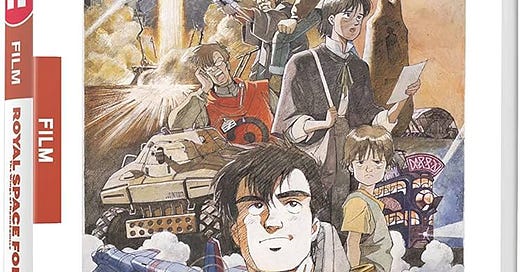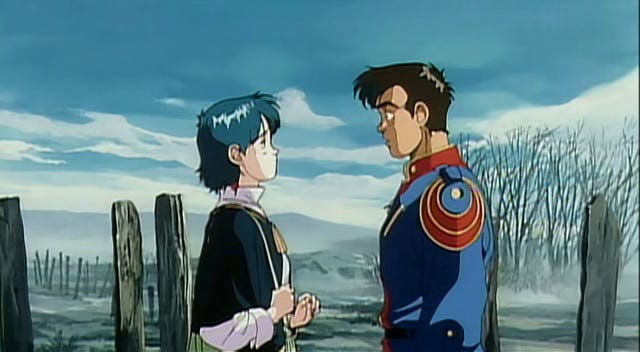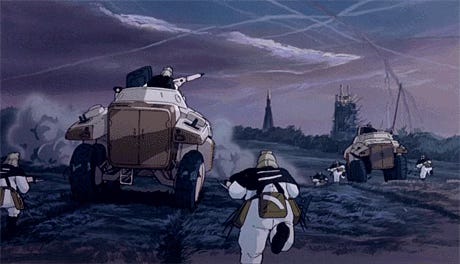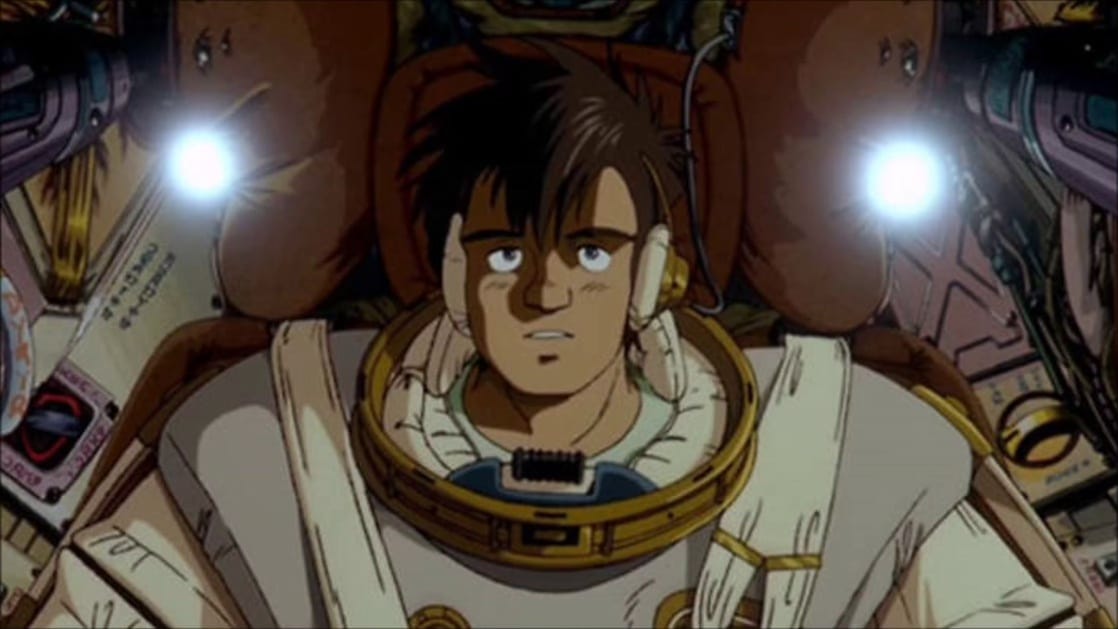RE:Animetion - The Royal Space Force: The Wings of Honneamise (1987) Part II
Part I located here.
Ukiyo-e translates roughly to “Pictures of the Floating World,” and Hiroshige was the last of the great Japanese Ukiyo-e artists. The pictures of life in the Edo period would be carved on wood blocks and used for printing. However, it was his landscapes that made him great. He died two years after Admiral Perry opened Japan for trade. Modern printing techniques would make Ukiyo-e obsolete overnight. But unlike Europe, where the art and artists are now lost. Hiroshige’s work lives in the art form of manga.
There was an intricate vibrancy in his work that you can see in the background of The Wings of Honneamise
One of the biggest things Gainax was trying to accomplish was to separate the Honneamise world from Post War Japan. There is notably no nuclear weapons or even power hinted at. And yet the filmmakers couldn’t really get away from it. The trauma for Japan is simply too deep, but there was an attempt to get away from it.
The world of Honneamise is a bi-polar with the Honneamise monarchy on one end and the Republic on the other. However it’s made clear that the important decisions in both countries are made behind the scenes.
The public starts to take a keen interest in the Honneamise space program with Shiro becoming a celebrity astronaut, sort of like the Mercury 7. He starts making public appearances, doing advertisements, hanging out with members of the Honneamise Royal family, that kind of thing.
However, as Shiro rises in the world, Riquinni goes in the opposite direction. She said that the house she and her ward Mana were living in belonged to her aunt. When Shiro checks in on them, the electricity has been turned off. Next, when Shiro is at work, she calls in a terrified panic. When he gets there he finds out their house has been demolished by the electric company.
It’s never explained, but you now know she isn’t being straight with Shiro. I mean, no electric company is going to level your house for non-payment. We never find out how Mana came into her care, either. We don’t know if Mana is her secret daughter or what. It’s never explained, what matters is that Riquinni lives in squalor, and Mana has to live there with her. I should also point out that Riquinni represents the prevalent 1980s Japanese symbolism of the dichotomy between modern urban life and losing touch with the traditional Japanese rural life, with Riquinni living in the country and Shiro being a product of city life, (this would be expressed more explicitly when My Neighbor Totoro would be released the next year).
Shiro keeps trying to advance their relationship into something romantic but Riquinni keeps shoving him away. Their relationship is an odd one. Usually it’s men who put women on a pedestal, but Riquinni is the one who has unrealistic ideals about Shiro. At first, it pushed him toward the man he wanted to be. He became a man with a purpose, but it was for her, not himself.
However, when his senpai, Doctor Gnomm, dies suddenly, the wind goes out of Shiro’s sails. The space program runs into the usual headwinds of “this is a waste of money that could be spent on the poor.” Which has always been another way of saying, I want the money being spent on this high-visibility project, spent on my virtue-signaling hobby horse instead. Shiro’s idealism fades in the face of real-world corruption. Reading Riquinni’s holy book of pessimism doesn’t help either.
We find out that the Space Force was only ever started in the first place as a pork barrel project, and that no one in the government ever wanted it to actually succeed. Now they are actively sabotaging it by moving the launch site into a DMZ.
Shiro, for his part, slides into a depression. The rest of the Space Force is furious with him. He had become their contextual and situational Alpha male, and then all of a sudden, he’s just not feeling it anymore, leaving them leaderless
Shiro eventually hits rock bottom, throws the money in his pockets to beggars in the street, and walks off to find Riquinni. He hands out fliers with her.
She has moved into the local shrine with Mana. Shiro slumps down to the floor of the place in complete depression. Not moving or eating. He sees Riquinni come in and discovers that she is hoarding money. He stares at her bare legs and begins to glower at her. She’s been lying to him all along, and now he knows it.
That. Scene.
What comes next is the most controversial scene in Wings of Honneamise. Some people insist that it completely ruins the film. That the character of Shiro as presented so far would never have done such a thing, and that they can’t forgive the movie for it or continue to watch it afterward. Others feel that it is needed because it’s the lowest point for a man who was on a downhill path, that it was Shiro’s rock bottom moment that he had to reach before he could find an upward path.
Riquinni steps behind a partition and starts to change clothes. Shiro rises from the floor, glowering, he slams the partition aside. Riquinni screams and covers her bare breasts. Shiro pushes her to the floor and starts forcing himself between her legs. Then he sees her anguished face and stops. Shiro is horrified at what he was doing. Riquinni takes that moment to clock him in the side of his head with a candlestick, knocking him cold.
This was not some hentai scene meant to titillate. It was there to show a man who had been trying to be good, at his absolute worst.
Did it go too far? That is a question every viewer of this film has to answer for him or herself. For some, it does ruin the movie. For others, it's an intensely uncomfortable moment, but it succeeds at what the filmmakers needed it to do. I would argue it went just far enough. If Shiro had completed his despicable act, he couldn’t have come back from it. I have noticed that there is a generational divide to this scene. Younger viewers are far more likely to find it completely unforgivable and inexcusable. Older viewers who have ended relationships by being in the one in the wrong can at least understand what it’s like to know you’ve thrown a punch you can’t pull back.
In the morning, a clearly contrite Shiro tries to apologize, but Riquinni begs his forgiveness for striking him. This is the part that makes That Scene work. It’s her apologizing for resisting him. Her regret for doing the one thing we’ve seen her do to preserve her own integrity. She loathed herself for the one time she wasn’t a doormat. And even seeing Shiro at his worst, she can’t take him off the pedestal she put him on.
Their relationship, for what it was, is over.
After this incident, Shiro rejoins his friends in the Space Force, who want to know where the hell he was all weekend.
Shiro asks his best friend Matti if he ever wonders if he’s the bad guy in his own story.
And I don’t want to spoil Matti’s answer. Go see it yourself if you want to know, but it did showcase the subtle play of expressive emotions on the characters’ faces. This is a film where the cartoon characters genuinely acted.
After that, the action picks up. The film concludes in spectacular fashion with the Republic trying to capture Shiro’s rocket while the countdown to launch progresses. Ground fighting, dog fighting, and a gorgeously animated launch scene.
At the end, when Shiro is in orbit, he asks his world to join him in prayer. Perhaps he is the one to have lifted the curse of Dao after all. Or at least being the one who has tried.
While I feel that Wings succeeds at what it was trying to do artistically the same could never be said for it financially. That was entirely the fault of the people trying to sell it.
The Wings of Honneamise was initially released in Hollywood at Grauman's Chinese Theatre a month ahead of the Japanese release. The Hollywood premiere was a demonstration of just how disastrously clueless the marketing for this film was. The American release was renamed Star Quest and had just one showing. Dubs were pretty bad back then, but this one is generally regarded as the worst of all time. The filmmakers were appalled to discover that the dubbing company Go East had never received a script and just sort of made up their own story. To their credit, when Gainax showed them what the script was supposed to be, Go East begged for a chance to redub it. They were denied. Star Quest’s only purpose was to make it look like it was something big in America.
The marketing failed to do what marketing is supposed to do. “The aim of marketing is to know and understand the customer so well the product or service fits him and sells itself.” This is an end that is pretty hard to achieve when the marketers don’t understand the product themselves. The firm they hired had had success with Nausicaa of the Valley of the Wind, and that was kind of like Science Fiction, right? So the title was changed from The Royal Space Force to the drastically unwieldy The Royal Space: The Wings of Honneamise, mostly so they could have The NOUN of the NOUN in the title. In fairness, the plot was so subtle and complex that the title was always going to be a challenge.
But they did so much worse than that. They made out Shiro and Riquinni’s relationship to be this grand, passionate love affair that would be remembered through the ages. They tried to give the impression that one of the production stills that was never used contained a magic boulder.
This is the worst kind of marketing a film can have, one that is trying to trick the audience into thinking the film is something it isn’t. The only thing I can give them is that this was a very subtle and complicated narrative that couldn’t be easily explained in a three-minute trailer.
The reviews were mixed, and audience reception was one of confusion. They thought they were going to see something like Nausicaa, and instead it was closer to 2001: A Space Odyssey.
It nearly destroyed Gainax. They survived by doing piecework animation for other studios. This kept the lights on until they could make Nadia and then Gunbuster.
On the tomb of Icarus, who flew too close to the sun, are the words “Greatly he failed, but greatly he dared.”
The Wings of Honneamise remains a foundational work of the art of the animated motion picture. Its soaring ambition, its philosophical depth, and the beauty of its artistry equaled the intentions of the scholarly paper it was built upon. It remains a bold statement of what animation can achieve,Part I located here. but so rarely does.
Discuss in the comments below









How can you watch this today? It looks like Bezos only sells region B Blu-rays with no English subtitles.